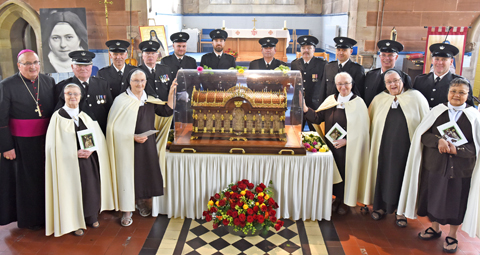October 25 | ![]() 0 COMMENTS
0 COMMENTS ![]() print
print

Called to serve the world in love and prayer
Sr Allain Docherty from the Carmelite Monastery in Dumbarton on why vocation to Religious life still appeals today
In the wake of the recent visit of St Thérèse of Lisieux to Scotland it seems fair enough to be asked what the Carmelite vocation is like today for the women called, like Thérèse, to the Carmelite life.
Women have been entering the Carmels of Scotland for more than 100 years. Like all religious Orders, Carmel has had to develop and adapt to the times we live in. But the essence is the same as in St Thérèse’s time.
A Carmelite vocation is essentially the following of Christ in prayer and contemplation. St Teresa of Avila (1515-1582) founded her Carmelite communities during a very turbulent era in the 16th century, to pray for the Church and for a world in need of prayer: what’s new?!
Focus
While the set-up of the community is meant to be conducive to a life of prayer, the cloister aspect is intended to reduce the ordinary distractions and make it easier to focus.
The ordinary household tasks, earning a living, Liturgy of the Mass and the Hours, the Eucharist, as well as the hours of silent prayer and of recreation together, the ups and downs, all fill the days and are the ambience for learning to walk with Christ and share in his Paschal Mystery.
Community life can be a challenge. And yet it is being part of a spiritual family who support and care for one another.
Everyone has a vocation, a call, a leaning, to a particular way of life. The vocation to the religious life might be experienced as a ‘drawing’ to that particular way of life, perhaps vague at first, and which subsequently has to be tried and tested.
Different experiences
Because people are all different, no two vocation stories are the same. Some entered our community when they were quite young; others have entered after completing their professional training or during a career. Personalities are different too. God takes us as He finds us and that adds to the vitality of a community.
Circumstances in God’s providence guide our footsteps on this journey. It is never a blinkered decision. Love of family and friendship and the normal attractions of life are strong. But somehow we get there.
And that is only the beginning. Vocation is not just about entering but it is about continuing life, not so much about why we came as why we are still here! We change in life and life changes us.
It was in this Carmelite milieu that St Thérèse of Lisieux lived for nine years. The fruitfulness of her short life was clear to see during the amazing response to the visit of her relics to Scotland in September. Thousands of people flocked to her.
Heart of the Church
In her desire to be ‘love in the heart of the Church’ she had learned to sanctify the little things of her life, to transform them in love, to carry the Cross, living and growing in intimacy with Christ, day after day bringing before Him the intentions of so many, the hearts of a broken world.
And so it continues! It is the mercy and love of God that continues to hold us and is the reason why we are still here, realising that we are not called to save the world, because after all, that has already been done by Christ.
We are here to follow Christ and to serve the world in love and prayer, to be servants of love.
So what is happening to ‘vocation’ nowadays? Has God stopped calling young women to Carmel? Is this a time of pruning the vine? Or is the Voice not being recognised and the vocation not realised?
Communion with God
However we answer, there is always the thirst for God in the human heart and the longing for deeper communion with Him and others. That is what Carmel is all about: friendship and relationships, with God and with each other.
Perhaps Thérèse of Lisieux has already whispered into a few hearts. If so, don’t be afraid to explore her invitation in prayer. After all, prayer is the way to discern all our dilemmas, as well as the way of life in Carmel.
Over 100 years ago, Alfred Lord Tennyson expressed this beautifully in his famous poem, Morted’Arthur:
More things are wrought by prayer
Than this world dreams of. Wherefore, let thy voice
Rise like a fountain for me night and day…
For so the whole round earth is every way
Bound by gold chains about the feet of God.
St Teresa of Avila was quick to warn against building castles in the air. She insisted that what matters is that we focus our love on the persons close to us.
We can all do this and, like Thérèse of Lisieux, keep the love pulsing through the heart of the Church, in the service of Christ’s great mission.










